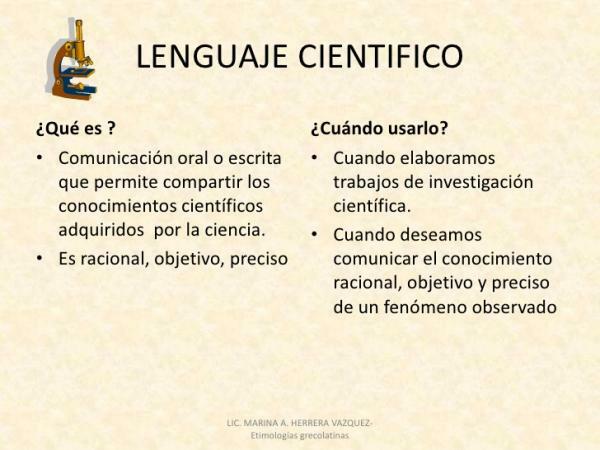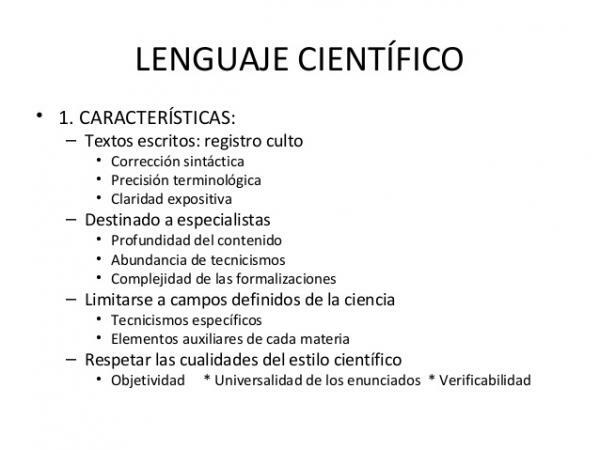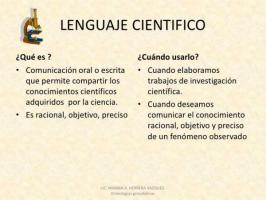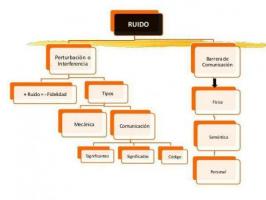Scientific language: characteristics and examples

Image: Slideshare
Each of the areas of knowledge has a series of linguistic elements that differentiate it from the others and that are incomprehensible to those who have not acquired a certain training in the matter in question. We are referring to the different scientific languages. An expert in a branch of knowledge uses terminology and structures when he speaks or writes about his discipline that are different from those he uses in his everyday life. In this article from a PROFESSOR in addition to giving a definition scientific language, its main features and a series of examples to illustrate them.
Speakers of a language use it differently depending on:
- His social circumstances, according to which we differentiate diastratic varieties. These are given by the levels of education and culture and by the social stratum of the user.
- The place where it comes from or where it lives, according to which we differentiate diatopic varieties. In each geographic area we can find unique grammatical and phonoprosodic features.
- The situation in which a speaker finds himself at a given moment, according to which we differentiate diaphase varieties. A user of the language changes the way he speaks depending on where and with whom he is.
- Within the diastratic varieties we find the specific languages, those that identify a specific sociocultural group. They serve, therefore, as a sign of identity, but also to designate objects, concepts or relationships. There are four fundamental types:
- The slang or argots They have a cryptic purpose and seek to differentiate one group from the rest (here we find juvenile jargon, prison language, that of some urban tribes, etc).
- The sectoral languages They are those of a specific profession (sports, legal, journalistic, etc). They do not have a cryptic purpose.
- The technical languages They seek to transmit knowledge and instructions with practical applications. There are in computer science, engineering, medicine, etc. They have no cryptic purpose.
- The scientific languages They seek to transmit knowledge of different sciences and disciplines, such as biology, medicine, physics or linguistics. They have no cryptic purpose.
In this other lesson we will discover what are the language registers so that you better understand how the act of communication occurs.
This time we will focus on scientific language, that which is specialized in the transmission of knowledge of scientific disciplines. Each scientific text focuses on a concrete matter and is aimed at people who are experts in it. This makes the understanding be hard for those who do not know the specialized terminology. Scientific language is the result of a tacit consensus among its users, making it a conventional language.
Their features are as follows:
- Using a unique vocabulary and therefore monosemic. The use of neologisms, cultisms and loans is very common. It seeks to avoid ambiguities.
- Use of a language denotative, with a scarce and precise adjectival.
- Search for a language objective (in which opinions or feelings are not expressed) through the use of the third person plural and impersonal sentences, as well as the plural of modesty.
- Search for the major precision and clarity possible through the use of a schematic syntax, with simple sentences and no periphrasis. As a consequence of this economic language, rhetorical embellishments are not abundant. It is tried not to fall into redundancies.
- Absence of particularisms, it is sought to use a Universal language.
- Use of the present indicative (for theses) and the present indicative or future subjunctive (for hypotheses).
- Tendency to explain himself, thus fulfilling a metalinguistic function.
- Introduction of formalized elements such as schemes, diagrams, mathematical symbols, plans, chemical formulas, etc.
There are also other types of languages such as, for example, ltechnical language.

Image: Slideshare
In the following examples of use you can see the characteristics mentioned:
"The fundamental purpose of the linguistic analysis of an L language is to separate sequences grammatical which are sentences of L, of the sequences ungrammatical that are not L sentences, and study the structure of grammatical sequences. The grammar of L will therefore be a device that generates all the grammatical sequences of L and none of the ungrammatical ”.
Noam Chomsky, Syntactic structures
“The change in conditions produces a hereditary effect, as in the time of flowering plants when they are transported from one climate to another. In animals, the increasing use or disuse of organs has had a more marked influence; thus, in the domestic duck, I find that, in proportion to the whole skeleton, the wing bones weigh less and the leg bones more than the same bones of the wild duck, and this change can surely be attributed to the fact that the domestic duck flies much less and walks more than its parents wild".
Charles Darwin, The origin of species



